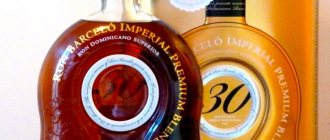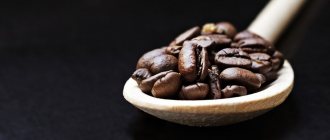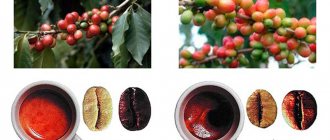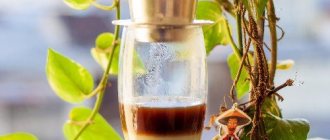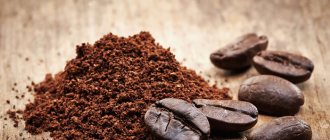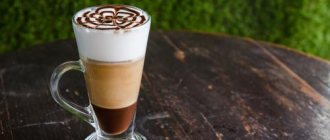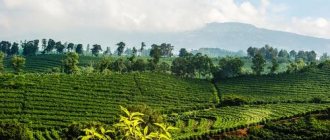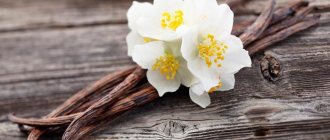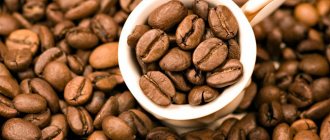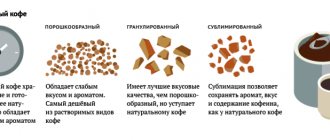General information about the coffee tree
Congo tree, or robusta, is a plant native to Africa and the equatorial forests of Asia.
The main feature of this variety is its strong taste. The name is translated from one of the African languages as “strong”.
Origin story
Due to the fact that robusta beans originate from the Congo River Basin in Uganda, where the rugged plants were first discovered in 1830, this variety is also called Congolese coffee. The drink made from such raw materials was bitter, which negatively affected sales, because... European and American coffee drinkers preferred softer Arabica beans.
However, at the end of the 19th century. Its main plantations suffered from leaf rust and were completely destroyed. Then planters turned their attention to robusta because of its disease resistance and high yield. Trees were exported from Africa to other parts of the world, where they quickly took root.
The 1954 frosts in Brazil, which destroyed Arabica plantations, forced the government to allow farmers to grow a hitherto unusual variety. Then the largest manufacturers of ground coffee began to add such beans to their products. In Italy they found that 10-15% robusta increases the tonic properties of espresso and gives it a chocolate taste.
Places of growth
Wild coffee trees from the Congo grow up to 10 m in height. On plantations they are pruned to form a bush crown. They require a humid climate with an average annual temperature of +22…+26 °C.
The plant is not picky and has no special requirements for soil composition, climate, or location of the site.
The largest suppliers of the London Coffee Exchange are:
- Guatemala, where Robusta is grown together with Arabica. To increase the yield, owners graft cuttings of the second variety onto the stem of the first variety.
- Liberia has fertile soil and suitable climatic conditions. The grains supplied from here are characterized by a special aroma and increased strength and amount of caffeine in the drink made from them.
- Tanzania, where Robusta is not the dominant crop. However, coffee from these places has a deep taste and a slight pleasant sourness.
- Angola, which before the civil war was one of the five largest exporters of the Congolese variety. Now production is quickly recovering. The finished drink has a chocolate-sour taste and a high caffeine content.
- Vietnam is the largest supplier of robusta. Its plantations occupy about 90% of the coffee plantings in the country.
Robusta from Angola plantations has a tart aroma and a large amount of caffeine in the beans.
India, Ecuador, Cote d'Ivoire, Madagascar, and Indonesia also became major producers. Cultivation of the crop is prohibited in Colombia and Costa Rica.
Compound
Classic Congolese coffee includes:
- caffeine;
- amino acids;
- minerals;
- vitamins;
- sucrose;
- aroma oils;
- cellulose;
- organic acids.
How Robusta saved the coffee world
Until the 19th century, Congolese coffee was of little interest to arrogant coffee planters. But in the 19th century, an epidemic of coffee rust broke out in Sri Lanka, which practically wiped out Arabica plantings. Farmers remembered the sustainability of robusta and brought it from Africa. At the beginning of the 20th century, “Congolese” plantations appeared on the island of Java.
History repeated itself 100 years later on another continent. In the 70s of the last century, a serious epidemic of the same coffee rust brought the coffee industry of South America, or more precisely, Brazil, to the brink of extinction. This country was then the leader in the supply of coffee to the world market. But after infection with rust, entire planting regions died. Disaster was averted by the humble Robusta. The Brazilians used the experience of East Asia, and the dead plantations were replaced by new species.
Seems like a good ending to the story? It turns out not. Robusta fruited well in Brazil, but the quality of the grains was even lower than in East Asia. Hybrids, of course, gradually corrected the situation, but not completely.
In addition, once it enters the territory, the stronger and more stable Robusta simply begins to displace the refined but weak Arabica. And in our time, experiments continue to develop the ideal variety of coffee, which combines sustainability and unpretentiousness with good taste.
Over time, Brazil gradually restored supply volumes, although gourmets consider the quality of its coffee to have deteriorated.
The governments of some Central American countries have categorically banned the import of Robusta into their lands in order to prevent unwanted crossbreeding with local Arabica. This will inevitably lead to a deterioration in its taste.
Description of Robusta
This variety has its own characteristics.
Bean shape
It is round and large in size. There are varieties with grains twice as large as Arabica beans.
Taste characteristics
A drink made from the Congolese variety in its pure form is characterized by the following features:
- pungent, rough taste, which is why it was not immediately accepted in Europe;
- slight bitterness;
- high caffeine content - 100 ml contains the recommended daily dose;
- wateriness of the finished product.
Robusta has a specific aroma that is not to everyone's taste.
Types of coffee in Cambodia
Robusta and Arabica coffee varieties are common in this country. Robusta is the leader in consumption throughout the world (second place after Arabica). Since the cultivation of the latter takes place in mountainous areas, at an altitude of 900 to 2000 thousand meters, this poses a problem for the production of Arabica in Cambodia. Exceptions are varieties called “hybrid”, such as Liberica and Catimera.
Robusta and Arabica also have thousands of varieties - varieties with characteristic yields, growth levels, leaf thickness, and ability to resist drought. Each type is exclusive and unique.
Varietal varieties and hybrids
The most popular varieties were:
- Indonesian Java Katakan, classified as a specialty, with light sourness and nutty, licorice, malt notes;
- Angolan Ambry with a sweetish earthy flavor;
- dense and aromatic Brazilian Conillon;
- spicy-sweet Indian Bali Shinzan with clove notes and aromas of persimmon and pepper from Jamaica;
- citrus alpine Catura from Brazil;
- rare and expensive Latin American or Ethiopian Typica;
- Brazilian Bourbon Santos, collected from trees no older than 3 years;
- bitterish, with a taste of chocolate and spices Plantation A from India;
- fragrant Venezuelan Caracas;
- Indonesian Java Ineak;
- Quilu from Congo with maximum caffeine content;
- soft Blue Dragon and Sang Tao 1 from Vietnam.
Among the hybrids it is necessary to highlight:
- Hybrido de Timor - a mixture of Arabica and Robusta from the island of the same name;
- Mundo Novo, obtained by crossing the Typica and Bourbon varieties;
- Maragogipe is a low-yielding and expensive coffee from the Brazilian province of Bahia.
Beneficial properties for the human body
Most often, robusta is included in instant coffee varieties. Increased caffeine content gives energy and helps prevent diseases such as cancer, diabetes, bronchial asthma, cirrhosis of the liver and disorders of the genitourinary system. The drink has an antioxidant and tonic effect.
Robusta is a good energy drink due to its high caffeine content.
Features of application
Robusta accounts for about 30% of the coffee market. It is used in the following cases:
- For adding strength, bitterness and creating a creamy base in espresso blends. When adding milk, the taste is not lost in either latte or cappuccino. When refilling vending machines, pure Congolese coffee or a mix with its predominance is often used.
- Those who love a strong drink prefer single-origin. There are many such buyers in Russia.
- For the preparation of flavored and instant varieties. In these cases, bags and jars contain larger quantities of Robusta.
Rules for roasting beans
First, the coffee cherries are picked and sorted by hand. The pulp is then removed and dried before frying. The main rule is that the process continues until the second clap. The more the grain is processed, the brighter the taste qualities appear, and the brighter the aromas of the oils that make up the raw material are revealed. Several degrees of preparation of Congolese coffee are known:
- light brown Scandinavian;
- milk chocolate Viennese;
- dark French;
- almost black Italian.
There are 4 degrees of roasting of Robusta.
Criteria for choosing Robusta coffee
First, you should determine which flavor is preferable to purchase and select the desired variety and roast.
Preference should be given to ground varieties, because... they preserve the taste and aroma characteristics of the drink.
How to spot a fake
Coffee, which has become a popular product in many countries, is often counterfeited. The main way to obtain counterfeit goods is to replace an expensive Robusta variety with a cheap one. Only a specialist can recognize such a fake.
The second method of making a surrogate was the addition of impurities:
- starch;
- acorns;
- beans;
- barley;
- clay, etc.
You can distinguish counterfeits visually by determining the absence of color inclusions in the powder or by detecting the shell when the grain is broken.
Several factors should also alert the buyer:
- low-quality, sloppy or non-standard packaging;
- unusual taste;
- color uncharacteristic for the variety;
- lack of information about the contents and manufacturer on the package or jar.
A reliable way to protect yourself from buying counterfeit coffee is to get into the habit of purchasing coffee from trusted retail outlets and specialized stores.
Approximate cost
Although Robusta is cheaper than Arabica, its price cannot be lower than average. For different varieties they are approximately as follows:
- coffee from Uganda costs about 110 rubles. per 100 g;
- Indian Kaapi - 120 rub. for the same packaging;
- Vietnamese Typika - from 200 rub. for a similar bag;
- Brazilian Santos cannot be cheaper than 200 rubles. for 150 g;
- Blue Dragon — 230 rub. for 250 g;
- Me Trang from Vietnam - 450 rubles. for half a kilo.
Large packages of 1 kg do not cost more than 1 thousand rubles:
- Noir (Netherlands) - 750 rubles;
- Lavazza Gusto Forte (Italy) - 800 rubles;
- Lavazza Espresso Vending Gusto Forte (Italy) - 830 rubles;
- Bourbon Intenso (Italy) — 950 rub.
What affects quality
Arabica plantations still suffer from leaf rust, and farmers have to become more sophisticated. They cultivate Robusta using different technologies to achieve the best taste.
Baristas are against this variety. They believe that it does not have such harmonious taste qualities as Arabica. In fact, everything is not so bad. The quality of robusta depends on the climate and conditions under which the coffee was grown.
Interesting! Freeze-dried coffee: what does it mean and how is it made?
In poor countries like India and Indonesia, coffee is grown without meeting all technological requirements. Coffee trees are poorly cared for. And they can dry grains on old mats or wooden platforms, which are almost never washed. The grains absorb the smell of grass and earth. This spoils the taste of the coffee.
In Vietnam, robusta is grown by small farmers who harvest the entire crop at once, including unripe grains. This leads to a large number of defects and deterioration in quality. Today this problem is being solved at the state level.
To obtain an acceptable taste of the coffee blend, manufacturers prefer wet-processed Robusta. It allows you to get rid of the unpleasant smell of dried grains.
Methods for preparing the drink
There are several types of robusta drink. The easiest way is to prepare the 2 most interesting of them.
Glyase
Glace has many fans in many countries around the world. To prepare it you need:
- ice cream;
- syrup;
- chilled whipping cream;
- coffee prepared in a Turk or coffee machine;
- chilled whipped cream.
Robusta makes a very tasty iced coffee.
The ingredients are added in this order to special containers.
Oflameron
The cooking procedure is as follows:
- Grind the grains.
- Pour into a metal glass.
- Heat 60 g of water.
- Add it to your coffee.
- Place the container on low heat and wait for foam to form.
- Pour in 2 tablespoons of still champagne.
- If foaming occurs rapidly, remove from heat.
Production Features
For producers, the question of which is better, Arabica or Robusta, is also ambiguous: expensive beans can be sold at a higher price, but they are bought less often.
- Mass instant drinks are mainly made from robusta - it is the caffeine and coffee taste that are important, and all the nuances are easily adjusted with additives. Statements that someone makes freeze-dried coffee from selected Arabica beans are usually just advertising (although not always), and the composition honestly states “100% instant coffee” - most likely, it is Robusta.
In 2007, Maxwell House, a low-cost, commercial coffee company, switched its blend to 100% Arabica. Consumers who were not accustomed to distinguishing such shades did not notice much of a difference.
- A drink made from pure ground Robusta is too bitter, sharp, and few people like it, but in an espresso mixture it gives that same crema foam that is so valued by experts, a slight bitterness and overall strength. Therefore, it is added to espresso blends, especially in Italy. This greatly reduces the cost of production, although in many ways it greatly worsens the taste. The percentage of “bitter” grains can range from 10 to 60%.
- Pure Arabica is tasty, but such mixtures are also more expensive. Some people buy commercial grains, general supplies from countries, some prefer to work with single-origin beans from certain farms and regions, which have their own recognizable taste and aromatic shades, and allow you to get acquainted with the diverse world of quality coffee.
If the main thing for you is to cheer up, it is better to choose Robusta and blends with it; if you like soft, interesting coffee, Arabica is better.
Storage nuances
In order for Congolese coffee varieties to protect their taste and aroma, several rules must be followed when storing them:
- keep the packaging tightly closed in a place protected from direct sunlight;
- Do not place the jar or bag next to foods that have a strong or pungent odor.
It is recommended to store Robusta in a closed glass container.
Fundamental differences between Robusta and Arabica
The two varieties have a lot in common, but there are also differences:
- Place of origin. Robusta originated in Congo and Uganda, and Arabica originated in Ethiopia.
- The height of plants in the first variety is up to 10 m, and in the second - no more than 4.5 m.
- The gene code of a stronger coffee variety contains 22 chromosomes, while a soft Arabica coffee contains 44.
- The Robusta inflorescence is large and lush, unlike the Ethiopian species. The leaves, on the contrary, are droopy and hard.
- The fruit ripening period for a plant from the Congo is 9-11 months, while for a competitor it is 6-8.
- Plantations of one variety are unpretentious to the terrain and love a humid climate, while the second variety prefers high mountain areas with a warm environment.
- Robusta is more disease resistant.
- Arabica requires cross-pollination, while Congo plants are self-pollinating.
- Robusta is processed using the dry method and the color of the grain is uneven, while its relative from Ethiopia is processed predominantly wet. The fruits become monochromatic.
- The taste of Congolese coffee is tart and bitter, astringent, while Ethiopian coffee is gentle and aromatic, dense and oily.
- Unlike Arabica, Robusta allows you to get a lush, creamy foam. It is called crema (with emphasis on the last syllable).
- In terms of caffeine content, the drink from Africa is superior - there it is 1.7-4%. The Arabian variety contains 0.8-1.5%. Chlorogenic acid in products is 9% and 6%, respectively.
Every type of coffee has its fans and detractors. You can find a compromise by buying a jar of high-quality mixture made from natural grains.
What is Arabica
The Arabian coffee tree, from which the popular Arabica beans are obtained, began to be cultivated on an industrial scale in the 14th century in Ethiopia. But wild trees still grow here. It's not even really a tree, but a shrub.
When free, this bush can reach up to 6 meters, but it is pruned to 2 meters to make it more convenient to pick berries.
Bush-trees of this variety are beautiful, but they require constant care. They require constant attention and adherence to temperature conditions. Plantations are usually located in the mountains at an altitude of 2000 meters. Read more about this type of coffee in the article “What is Arabica coffee.”
Interesting! Mocha coffee variety - how it differs from the rest, the most popular varieties and roasts

